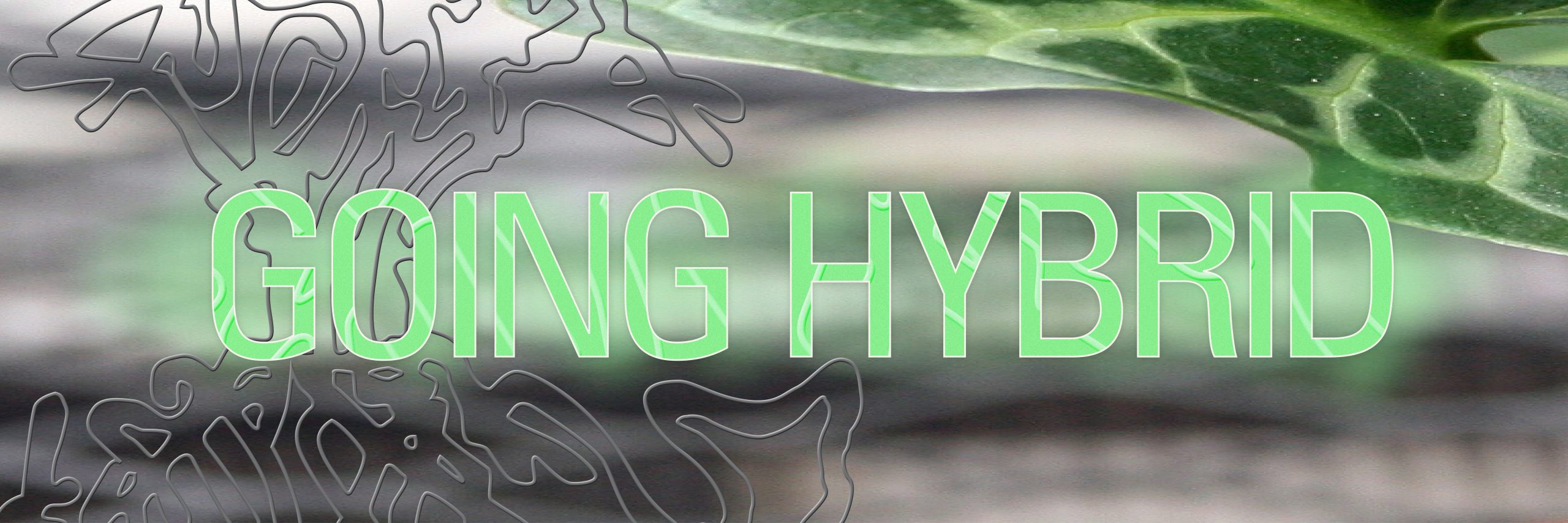Do you find yourself in TikTok limbo? Ever since the video-sharing app popped up in 2016, TikTok has become an omnipresent media whose discursive content is having impacts well beyond the containment of the platform. Following its predecessors Vine and Musical.ly, TikTok prioritizes short-format videos, self-referential humour, and user duetting. In the absurdity and vastness of our digital existence, TikTok is the place where niche internet cultures blend with the mainstream through an uninterrupted outpour of micro-trends. As addictive as it is endless, the draw of the TikTok algorithm has us scrolling away the days. But how is TikTok becoming more than a pastime distraction? What is the amplifying power of this platform within wider public discourse? That is the question that was explored in the panel Trends, Tactics and Aesthetics: The TikTok Limbo
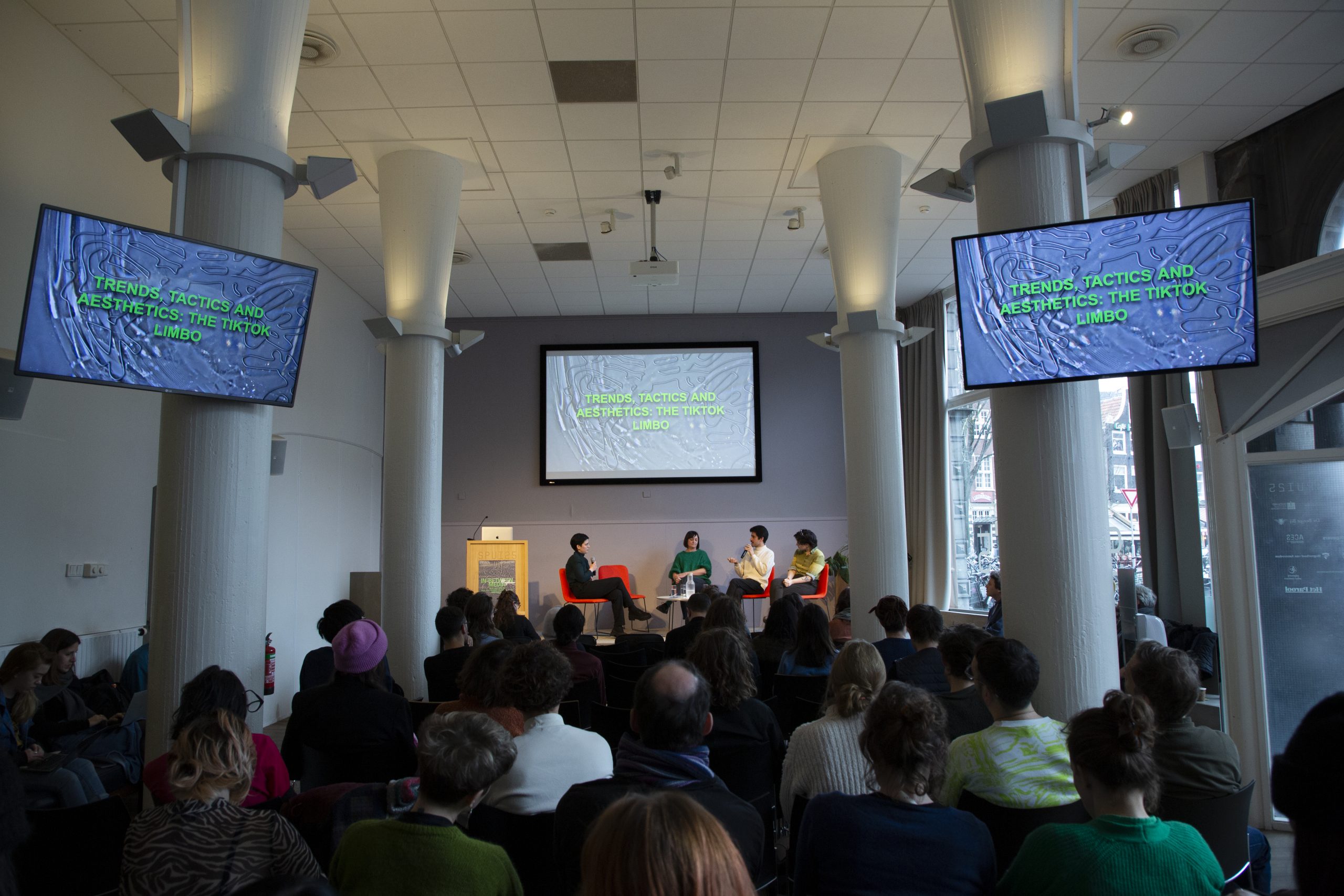
Dunja Nešovič, Tina Kendall, Jordi Viader Guerrero and Agnieszka Wodzińska: Round Table
We are seated facing a stage at SPUI25, an open space on the ground floor that is filled with natural light coming from the large windows that face onto a lively town square. Although it is cold and misty outside, the space feels quite bright. There is a podium as well as a table and chairs set up for the round table discussion that will conclude the panel. After a compelling lecture given by Joana Moll which successfully set the tone of the day, the audience seems engaged as we all shift our attention to Dunja Nešović and she introduces the panel: Trends, Tactics and Aesthetics: the TikTok Limbo.
Dunja shares that the following panel is a dynamic inquiry into what some consider the youngest, most popular as well as controversial social networking site, TikTok. While many dismiss it as frivolous and mind numbing, others are concerned of its potential as a tool of Chinese state surveillance. It was announced on March 21st that the Dutch government will be banning the use of the app on government officials’ work phones.
TikTok, a short-form video sharing app, represents a paradigm shift in social networking and has become a site of contestation and negotiation. Through exploring user practices, nascent subcultures and the potential of the platform to be appropriated as a tactical medium the panel aims to examine the amplifying power of the platform within wider public discourse.
Tina Kendall: Bored in the (Hybrid) House: TikTok as Ludotopia in a Time of Crisis
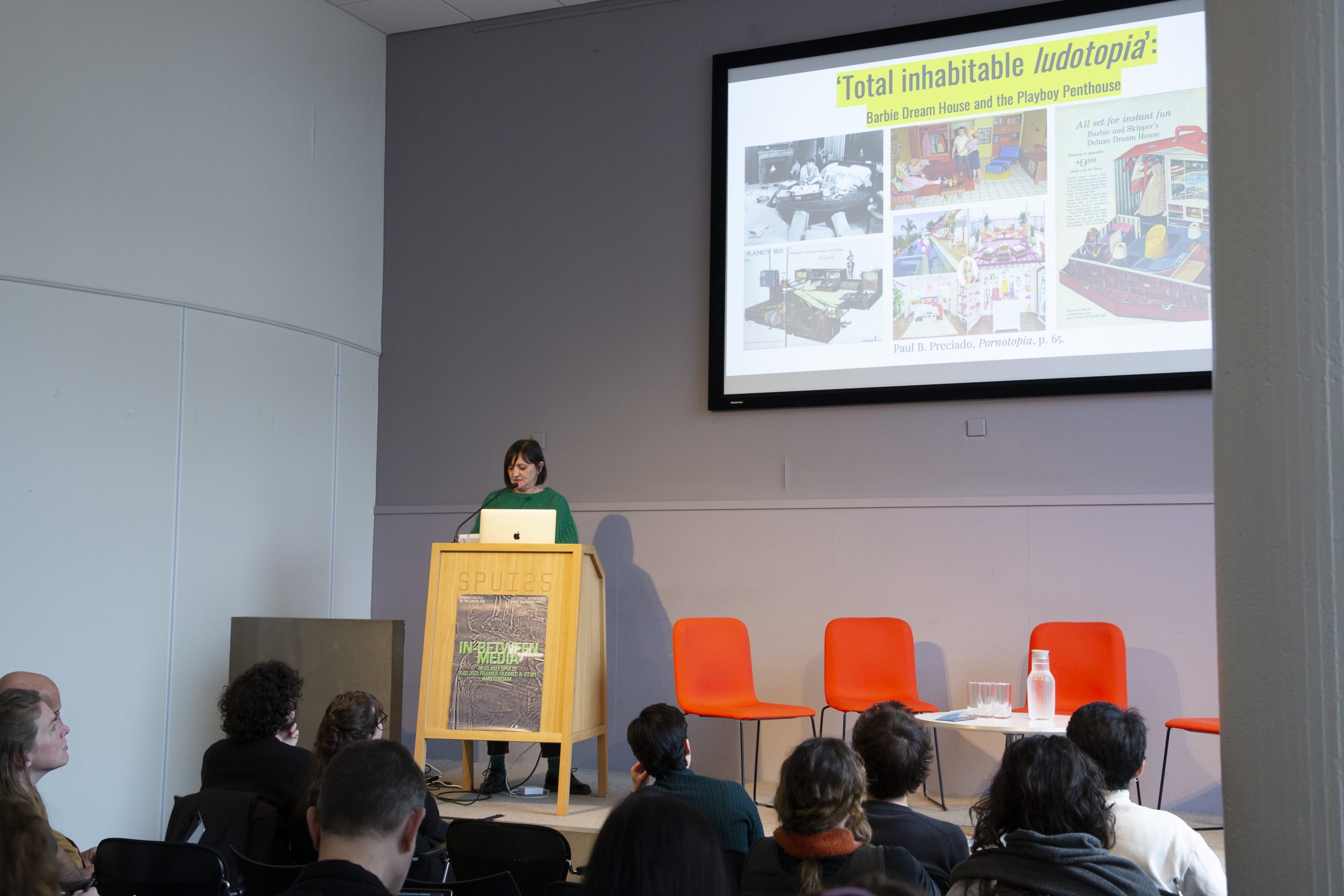
Tina Kendall presents ‘Total Inhabitable Ludotopia’
The first speaker on the panel is Dr. Tina Kendall, whose work focuses on boredom and the attention economy of networked media. She explains that as we are moving from the pandemic period into an era of permanent crisis TikTok has become the ideal tool for addressing the realities of home confinement, the “pandemic’s bored body problem.” She witnessed the response of creators when due to the pandemic their homes began to feel like prison cells or zoo enclosures. All of sudden those stuck at home were coping with new realities and strange new temporalities created by the pandemic.
When Tina mentions the trending song that emerged on the app during the early days of confinement Bored In The House, the audience laughs in recognition. Trends such as #boredinthehouse, where TikTok creators lip sync along to the Curtis Roach x Tyga song, gave us a glimpse into the ways the confinement would inspire users to share in and combat a collective boredom using the platform.
User tactics were appropriated back into platform strategies and further reinforced Tiktok as a machine for converting home confinement into the joys of ambient play. Tina shares that something as simple as choosing a more interesting background for a zoom call was a tactic for this conversion of confinement into ambient play. An isolated home took on a series of new residences, while it began to symbolize a restricting enclosure, the feeling of being observed (on zoom) and entrapped, the act of staying home and the home itself also began to represent the performance of our civic duty, protecting ourselves and others.
Tina proposes that these tactics reinvented the home as ludotopia: inhabitable, multi-medial and totally open to public view. TikTok enabled the home to become a meta apparatus for fun and games. The app performs an important kind of work for mass boredom, the TikTok mediated pandemic home.
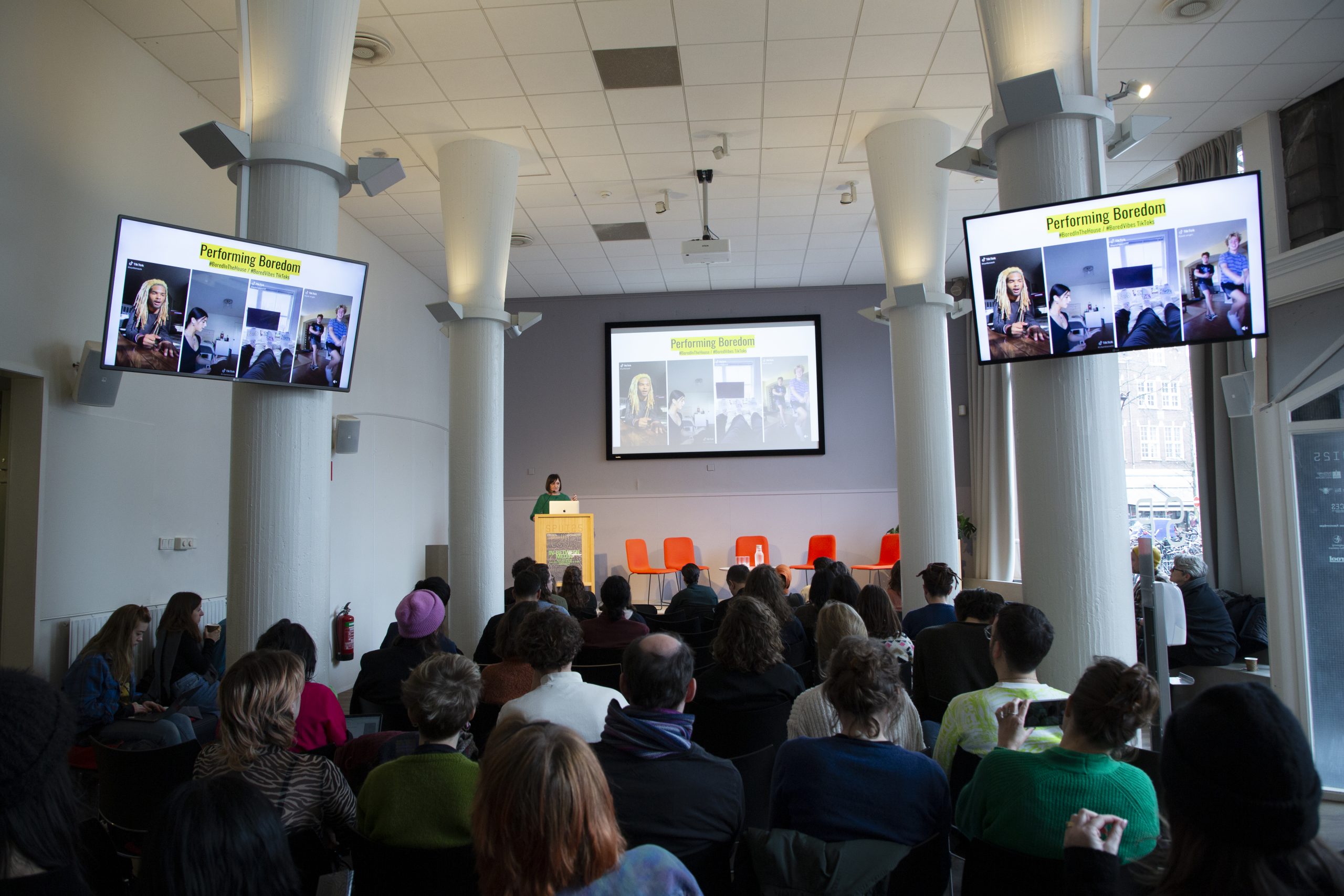
Tina Kendall presents ‘Performing Boredom’
She explains that the hashtags she looked at were #boredinthehouse and #boredvibes which contained both performative and stunt TikToks, both showed creators embracing the pleasures of full body participation encouraged by TikTok’s memetic structures.
Performative TikToks contained creators lip syncing and dancing which were all performing an important psychological function. These TikToks are essentially a performance of entrapment and are mirroring our shared experience of being stuck at home. The tone of these TikToks are playful, energetic and joyful. They are participatory, connective and create a co-presence between both creators and users. A social solidarity within the context of lockdown. It is with ambient play that this co-presence and intimacy are accessed, by moving beyond entrapment they create links with other creators who are also bored in their home.
Tina then moves on to describe stunt TikToks. These TikToks focus on the space of them home itself as the object of ambient play. They activate ambient play as a means of working on the sensory or affective texture of the home. Examples of these would be a extreme slip and slide courses, dirt bikes through the home or playing sports inside. Watching stunt TikToks have the ability to provide a certain kind of pleasure and a fantasy of escape. They reimagine the home as a playground rather than a prison. This is tactical as creators invented ways to produce the home as a joyful shared zone for creative invention. It opened up an awareness of the creative affordances that have previously been overlooked within the home.
Tina references the work of Ian Bogost who wrote the book Play Anything: The Pleasure of Limits, the Uses of Boredom, and the Secret of Games and quotes him, saying: “Fun comes from the attention and care you bring to something, even stupid, seemingly boring activities. It’s a foolish attention, even. An infatuation.”
Tina discovered that TikTok provides a set of tools to help produce powerful feelings of co-presence as well as enliven the rhythm and textures of the home. It introduces the home as a potentially endless party zone that yields to the whims of its inhabitants.
At the start of the pandemic TikTok created the #HappyAtHome campaign in an effort to contribute to the global stay at home effort ( https://newsroom.tiktok.com/en-us/staying-happyathome-with-tiktok ) which incorporated livestream elements. The platform benefited immensely from the global need to stay home and combat boredom. It relies on the bored body as a basic requirement of its model as well as domesticity as a condition of being bored in the house. The condition of being bored in the house can also be recognized as chronic to digital culture. As a result platforms like TikTok embody both the potential for tactical reinvention of the home and confinement as well as digital capitalism and control.
Agnieszka Wodzińska: Dead and Kicking: TikTok and Subculture
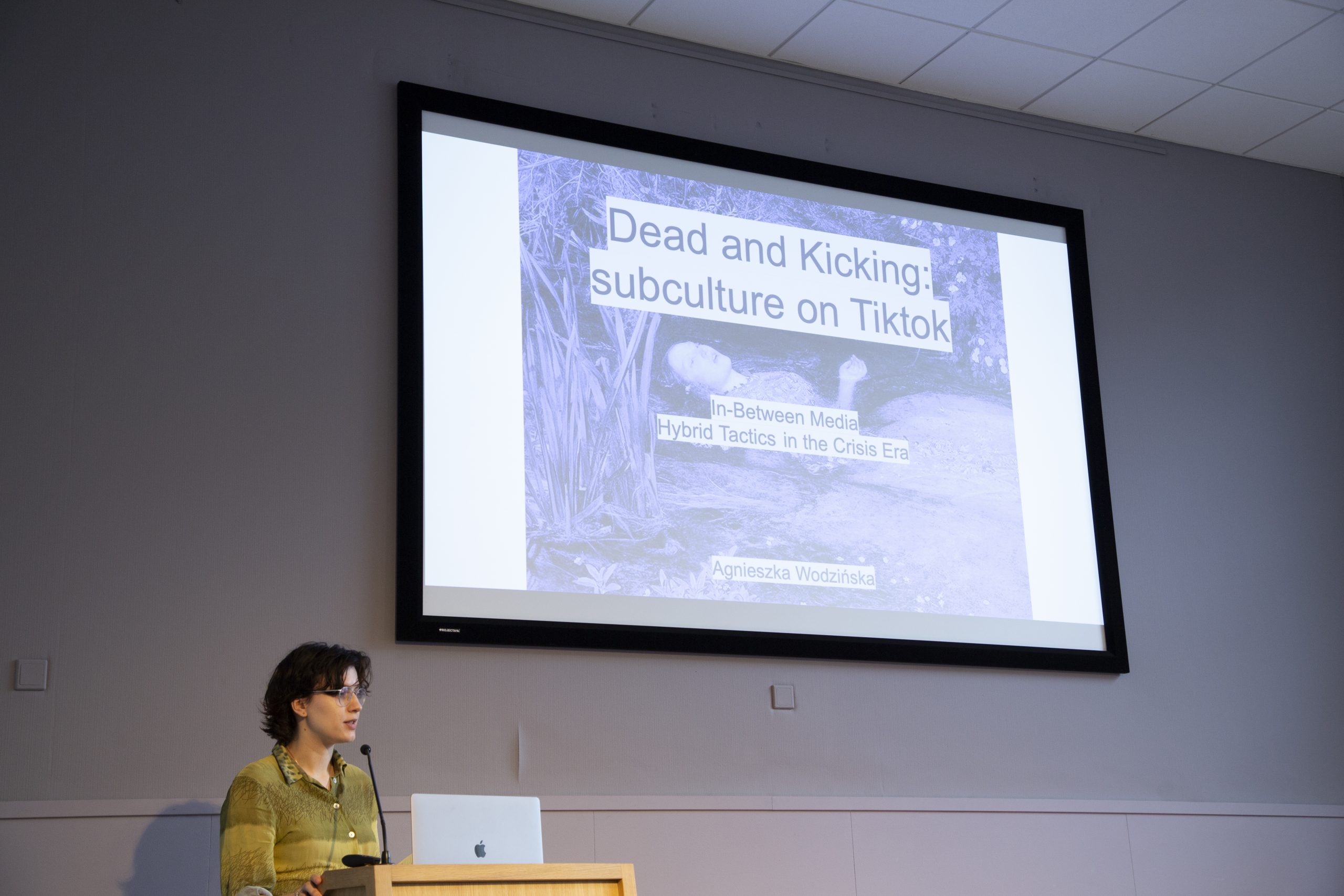
Agnieszka Wodzińska presents ‘Dead and Kicking’
Next on the panel is art historian Agnieszka Wodzińska. She is interested in aesthetics and the digital space, how aesthetics on social media platforms can become political and the limits of it.
She begins by sharing the definition of a subculture in the context of her research, “a group of users that both possess and express a certain interest and ideas that in some way are not mainstream or are counter hegemonic.” She gives the example of the trend #cottagecore which elicits nods and chuckles from the audience. The cottagecore trend with its slow living, back to the earth aesthetic, possesses a lot of potential for quite obvious anti-capitalism. On the surface it rejects toxic productivity and attempts to rethink our relationship to labour. It encourages those witnessing it to slow down, reconsider and take up non-digital hobbies. It is a reframing of domestic labour and illustrates a way to function outside of the capitalist and patriarchal structure. Although it began as a seemingly inclusive and progressive space there is a very clear overlap with the tradwife movement which has ties to right wing extremist spaces online. This rethinking of domestic labour then becomes the idea that unpaid, unrecognized domestic labour should be expected from women. These very different sets of beliefs fall under an eerily similar aesthetic which creates a dangerous ambiguity in aesthetics online.
Agnieszka then introduces her main topic for the presentation: the trend #corecore, this is followed by laughs of recognition from the audience. To define corecore she quotes Kieran Press-Reynolds “an anti trend, loosely defined as similar and disparate visual and audio clips meant to evoke some form of emotion.”
We are shown a TikTok video from the user @nichelovercore, a compilation of sentimental video clips, there are giggles from the audience when the TikTok ends with the apps familiar chiming sound. Agnieszka explains that corecore is an anti-trend, the name itself evokes a sense of self awareness and meta criticism. The videos explore the idea of compilation with overlapping clips; it evokes feelings of chaos. Clips come from already existing media, television ads, films, interviews, mass media and existing TikToks. They decontextualize and recontextualize content that creates a sense of disastisfaction with life within capitalism, they exist as critics of the platform in which the content exists. These videos have the potential for activating users that realize the elements of social media that are no longer working for them.
Agnieszka points out that corecore risks evoking a sense of self-pity for users, not activating them in a meaningful way. The videos highlight struggles and can lead to a collective sense of dissatisfaction. The message can be interpreted as romanticizing loneliness, saying “loneliness is beautiful.” It can create a de-political sense of individual struggle, focusing on the self without recognizing the issues at play. What Agnieszka did not expect while doing her research is how easily someone consuming corecore content can be shown alt-right related content by the algorithm. By making a new TikTok account and watching corecore videos she discovered that videos of or from controversial figures like Joe Rogan and Jordan Peterson would appear on her FYP, videos focusing on an obsessive self improvement that do not acknowledge the systemic issues at play.
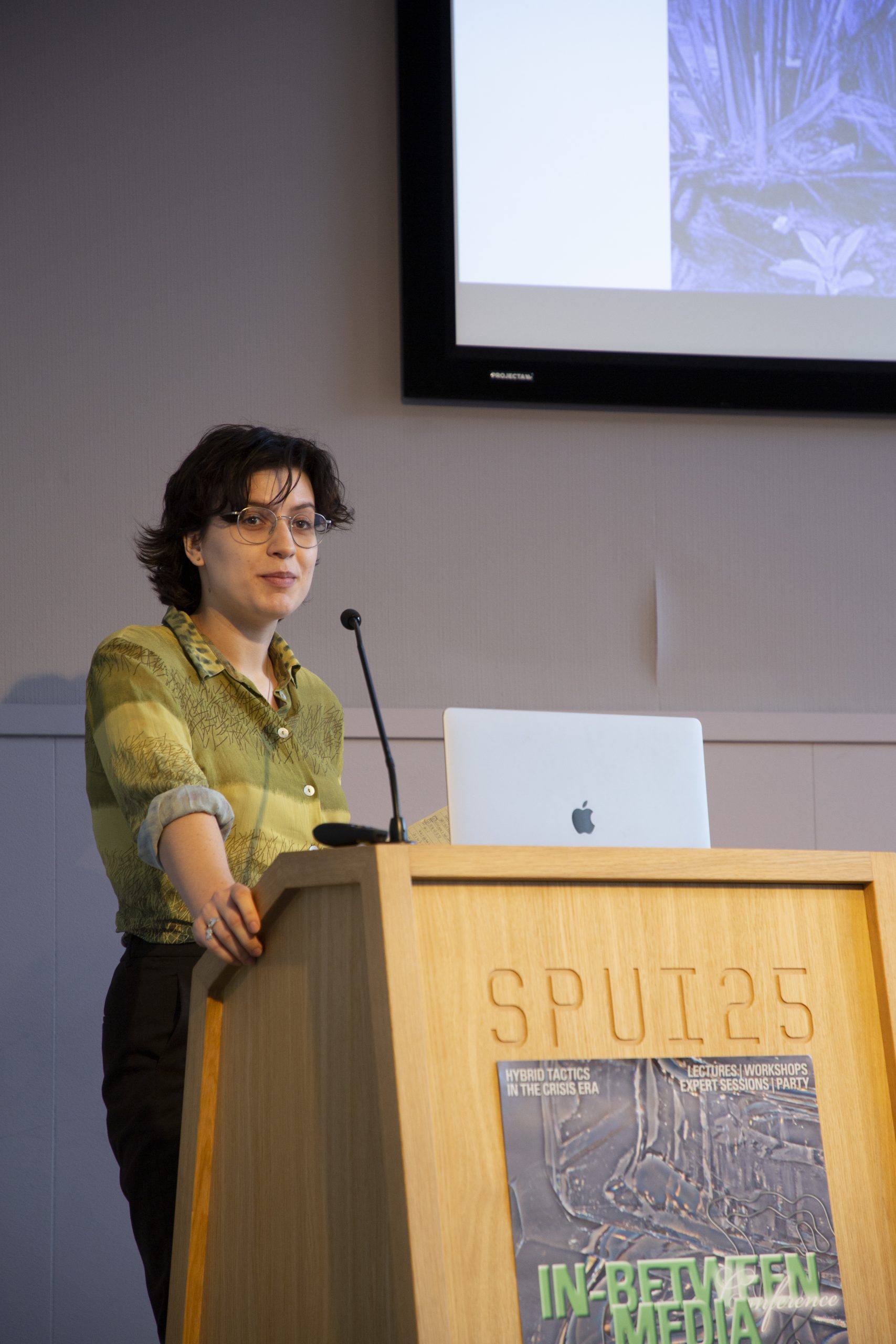
Agnieszka Wodzińska presents
One thing she discovered is that while corecore began as a sort of hopeless nihilism, now many videos tagged #corecore share the tags #hopetok and #philosophytok. She says that many subcultures exist as bubbles in a venn diagram and overlap in interesting ways. #hopetok videos contain more hope on the future of social media and societal relations and Agnieszka predicts that it may be a new direction we will be going with this type of discourse.
Agnieszka then explains that corecore videos are a form of sticky media, users want to come back to it and rewatch because they can’t be sure they caught everything. They think that there might be something in the compilation that will reveal itself to you if you just keep scrolling or replaying the video. She then compares the trend to zombie formalism (a term coined by Walter Robinson), that it is reviving ideas of modernism. It is possible that it captures soulless and performative motions, a simulacrum of originality that is desperate for a sense of development or progress. She says that we are so desperate for a sense of progress that we create false or artificial milestones, such as the first painting made from paint placed in a fire extinguisher.
She asks, is corecore going through the motions of aesthetical resistance without actually embodying it and making it its core? She explains that online subcultures are like zombie beings, they have skeletons that are recognizable to us, that share ideas between users and aesthetic interests. However, the meat of this body is from what she’s seen is kind of rotting and mutating to a point where it is hard to trance. Trends that are usually static and easy to trace have become more fluid and tricky with social media. This aesthetic ambiguity of online subculture, if we take time to think about it and its implication it could push is a direction of actual resistance and tacticality. “Corecore has the potential to be very activating for users.”
Agnieszka concludes her presentation with the question: “Is corecore something that can break out of this zombification or will it just continue existing and just be animated by the sheer speed of social media? Will the platform absorb this public critique or will there be away for users to break out of this very unusual cycle?”
Jordi Viader Guerrero: Infinite Scroll as a Symbolic Form
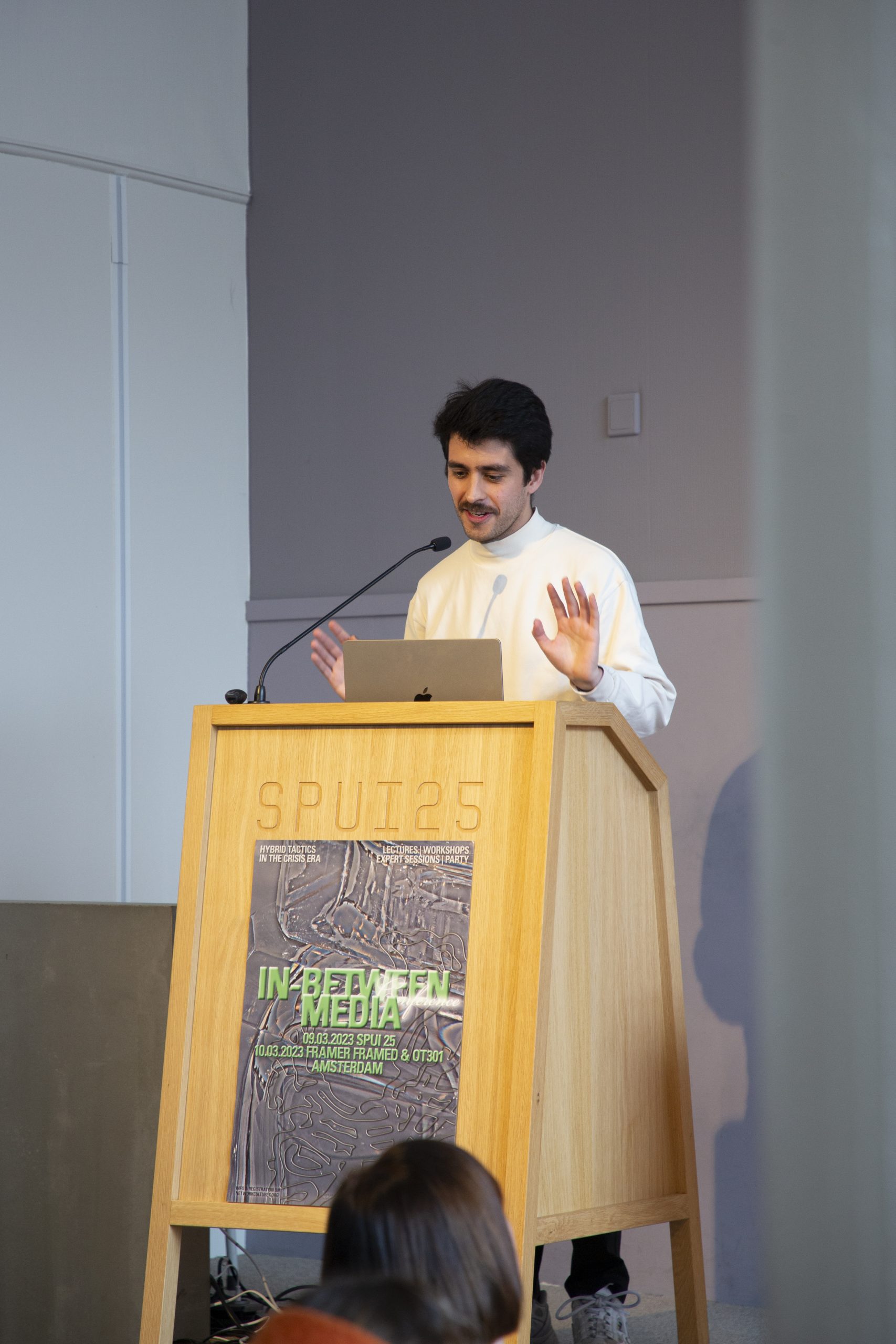
Jordi Viader Guerrero presents
Jordi’s presentation starts with a classic technological mishap followed by the audience’s knowing chuckles. The screen of his presentation is purple and it shouldn’t be. Once that has been sorted out he introduces himself. Jordi is a media researcher and PhD candidate at TU Delft. His research explores the intersection between philosophy, media, design, political theory, and technology. His project began during what he refers to as the darkest times of COVID. Early 2021. His goal was the abandonment of a specific way of doing theory and the issue of meaning. His project, called Infinite Scroller “proposes you, the reader/scroller, a general theory of scrolling —as much aesthetic, epistemological, and political—, while also encouraging you to experience theory as an overwhelming, multi-layered, and immanent event composed of networked text, images, and sounds to be seen, listened, touched, danced; that is, scrolled.”
He explains that he started by creating fragmented video essays about TikTok on TikTok (@infinitescroller). The aim was to make theory differently, to “scroll through theory.”
So, why scrolling? Jordi’s interest in it starts with the fact that scrolling is a practice that can be datafied. It is also a place of amazement. We spend a lot of our time during the day just sitting and scrolling. This is a motion that technological devices have created. He wants to see scrolling in a theoretical way, this perspective as a symbolic form. The visual perspective of scrolling has a deeper philosophical meaning. This is because perspectives structure the way we experience the world. So the question becomes: “how does scrolling come to structure the way we experience the world?”
Jordi says he abandoned the question of the symbolic and started to think about perhaps not asking what scrolling means to us but look at scrolling as something that we actually do. Something that actually exists in the world and happens. Scrolling is a material practice and so he wanted to take videos of himself actually scrolling. He opted to film himself at home while bored, scrolling to make his TikToks.
He says scrolling is a way to interface through these very complex infrastructures and it simplifies it to the user. It is a way to access information. Not just the access point but also the end. It is something we WANT to do, not for capturing or communication but for the sake of it. How can we complexify scrolling? The idea then became to denaturalize this reflexive physical loop of scrolling to make it opaque. To make the project difficult and complex.
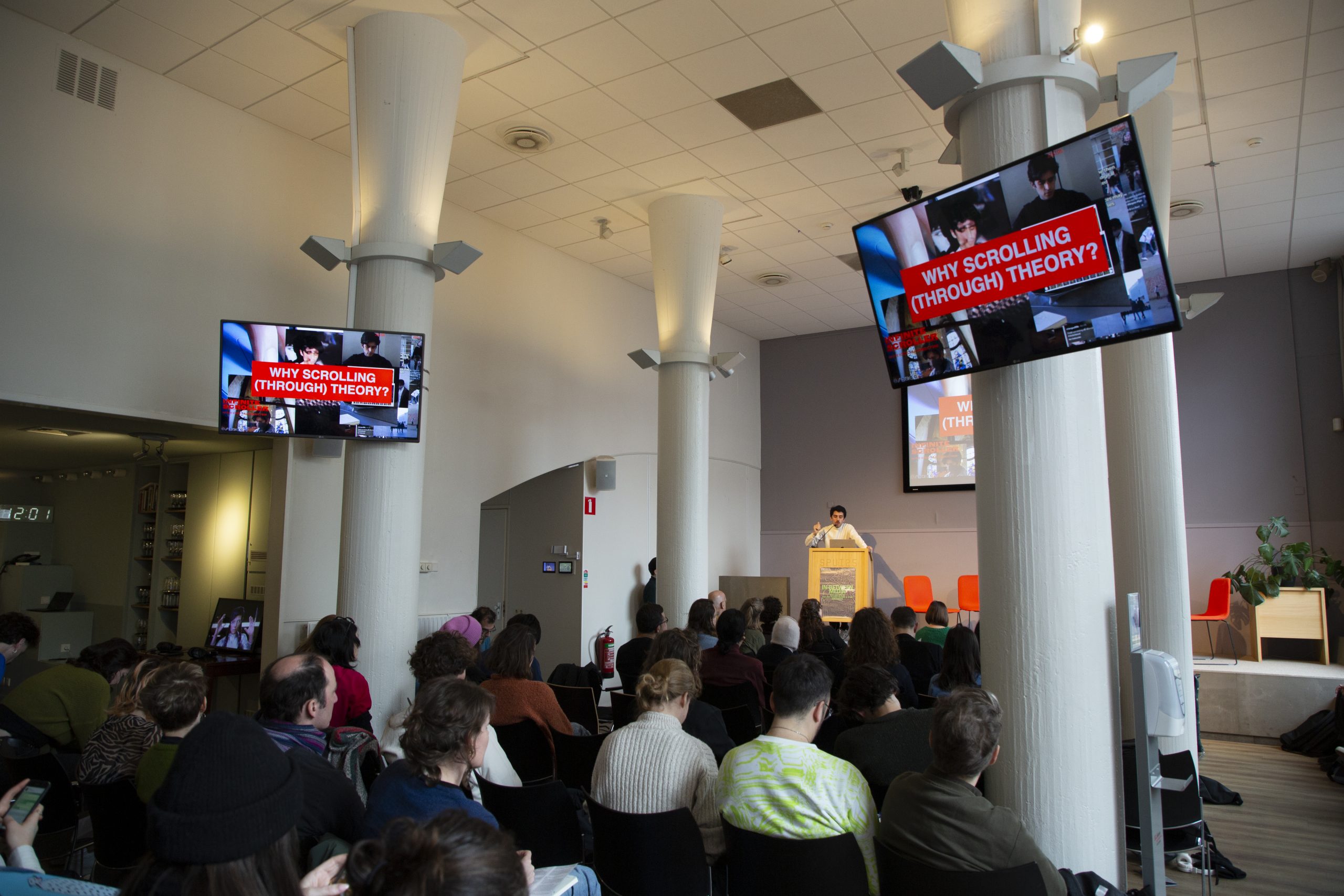
Jordi Viader Guerrero asks ‘Why Scrolling (Through) Theory?’
Referencing Agnieszka Wodzińska’s earlier presentation, Jordi says he was completely illuminated by corecore and its criticisms. He sees scrolling as a collective practice, not individual. It connects us both to the app and all this other existing infrastructure. There is no power of negotiation because these complex systems are being simplified. We are all made to come together and collectively participate in these systems.
Jordi asks, “why does scrolling have this power over us, why are we succumbing constantly into it?” Scrolling as a place for pleasure production. The information is not just for consumption but for pleasure production. He wanted to abandon theory, see scrolling as engaging in practices of pleasure. He admits that he did both TikTok and theory wrong in his approach to this project, he did not have a proper theoretical framework and the TikToks he made were very weird, there was no coherent line through it. The audience laughs as he follows this thought with a playful request to like and subscribe to his TikTok channel @infinitescroller. Now that he knows about corecore he says, his videos aren’t as weird as he previously thought. He explains that he had attempted to hijack or infiltrate trends to see if he could gain viewers for his videos but he failed and did not become a popular TikTok creator during the pandemic. His most popular video was located at a skate park so there is a good chance the viewers were skaters and that is why it gained views.
Jordi says: “we are scrolling machines, we are stuck there. Now what? What do we do with ourselves now that we’re trapped in this scrolling feedback loop?” He wants us to think of our relationship with these devices in different ways. To think of scrolling as a space of production. The audience laughs when he adds that that perhaps sounds capitalist in a way. He sees emancipation, joy, desire, emancipatory and positive passions coming from scrolling, basically Live Laugh Love. He concludes, “I’m too young to be too pessimistic.”
Round table with Tina Kendall, Jordi Viader Guerrero and Agnieszka Wodzińska moderated by Dunja Nešović
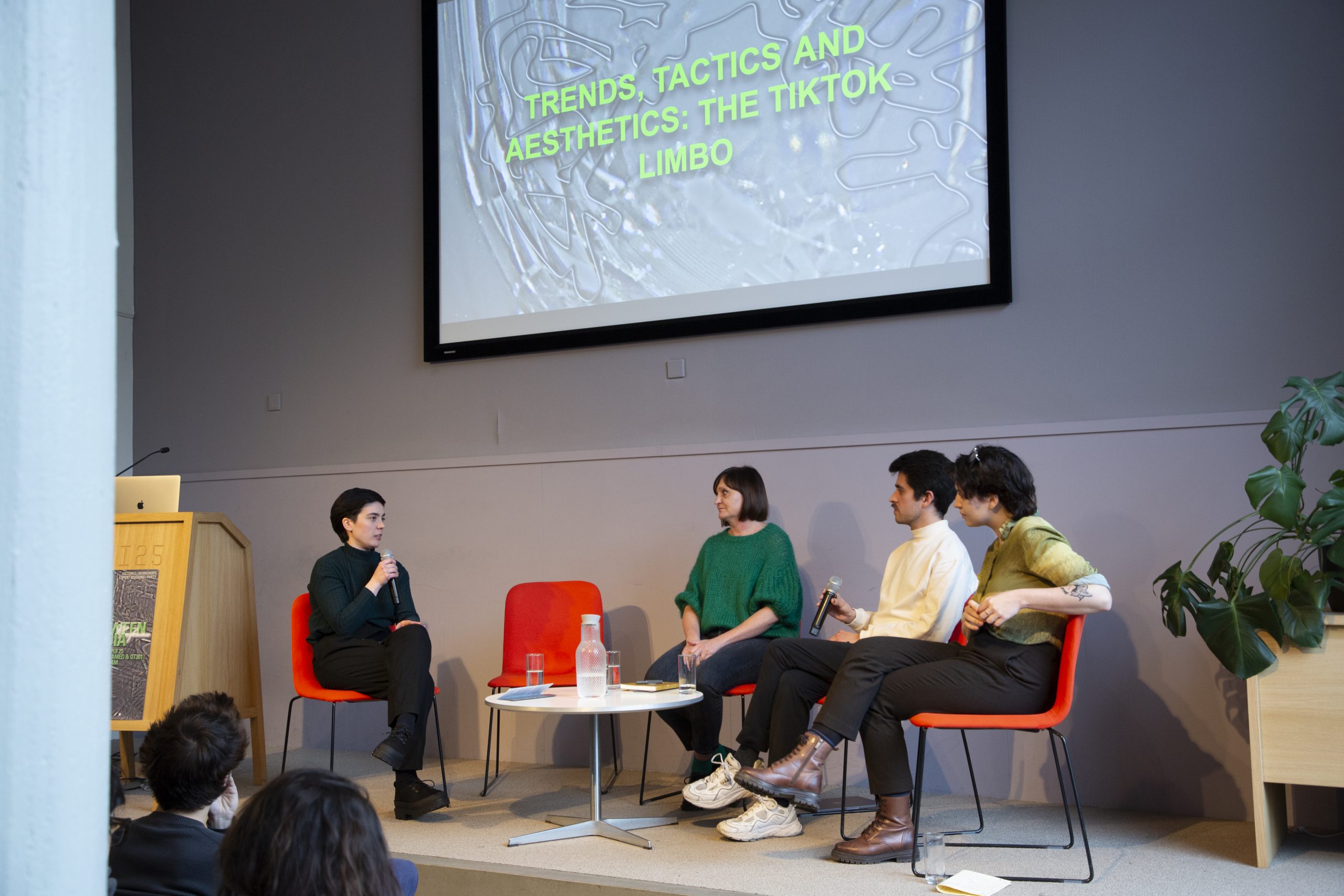
The round table starts off with some technical problems with the mics, which again elicits knowing chuckles from the audience. Dunja, Tina, Jordi and Agnieszka sit around a table facing the audience. Dunja wants to explore the potential for tacticality with TikTok and the notion of dual tacticality. She notes how boredom is appropriated and exploited by TikTok and there is a need from the users to employ media tactics. Platform intervention that are steering ideologies and dual tactics that generate in the platform environment. She asks “how are users are being invited to employ platforms to convey certain political or social action while also having to fight this platform giant that has its own interests in the matter?”
Tina is the first to speak, she says that boredom is a bi-political issue, boredom is activating the scroll as a mindless gesture. She says that she likes the way Jordi approached scrolling as an affective source of pleasure. During the pandemic she says she was involved with a young creatives program which pivoted to a co-creative project getting young creators to use TikTok to document what boredom felt like during confinement. They were encouraged to use TikTok in a way that was antithetical to the way it’s meant to be used. This included tactics such as setting their videos to private to be used as a diary space, any use that was different from what we are used to seeing. “They were trying to break the typical link between boredom being only this automated gesture that you shouldn’t think about anyway.”
Jordi says he is interested in the topic of boredom and platforms taking advantage of boredom. He bring up the classic internet insult of telling someone to go outside and touch grass which elicits laughter from the audience. He doesn’t think that TikToks are just boredom killers, they have the potential to be so much more. Looking back on the history of cinema, it used to be considered a waste of time, going to the movies to kill boredom. Now we regard it as a good and productive thing to do, it doesn’t have the same negative implications. We can “modify the parameters of what is expected of us to do with these platforms” by resignifying, reinterpreting and rethinking the gestures that are expected.
Dunja asks what are the different sites of subversion, reconceptualization of the platform, things that might not change the platform so much but resignifying, recontextualizing what you’re already doing? What are the possibilities for the users to change their attitude towards those types of appropriations instituted by the platform? Users perceive platform powers as marginal, tolerated rather than defeatist, a kind of acceptance that “we’re trapped now in this environment.” We are fighting against platform power, tension between the two ideological struggles between corecore being left-wing, these ideologies mutating into right-wing ideologies facilitated by the platform, fighting the algorithm as an ideological battle.
Agnieszka responds that users are attempting to navigate this struggle. The trick is to stay vigilant and think of the wider implications of the decontextualized snippets. The platform intends for us to view them as they all fit together but it is important to think of them individually. The ambiguity makes it interesting but also dangerous. Tina adds that the platform doesn’t recognize the ideological stance. “Is it the videos or the algorithm that dictate the ideological trend?” Agnieszka answers that it is unclear what role the algorithm plays in the creation of subcultures. She says corecore originally, this being only a few months ago (the audience laughs at the newness of the trend) was anti-capitalist. It then exploded into other hashtag subcultures. The fact that there is no cohesiveness makes it interesting and the platform does not want transparency of their algorithm.
Dunja then raises the question of affordances. “Are there certain ideas on what types of affordances on TikTok are relevant for being used in different types of tactical ways as well?”
Jordi responds that it is more interesting to create our own ecosystems to use the platform in specific ways. To create our own affordances instead of letting TikTok dictate the way we use it. We can do this by creating workshops, groups of students, friends, reading groups. By having a political purpose and using the media in different ways. The algorithm affords the creation of subcultures, we often end up in very niche sections of TikTok which would very clearly not be what TikTok wants as an image of their own platform. He says it’s as if you end up in this weird dark alleyway of the city and jokingly admits that he may be a defendant of filter bubbles. Jordi doesn’t think that the algorithm has full control of determining these subcultures and the different ways they flourish.
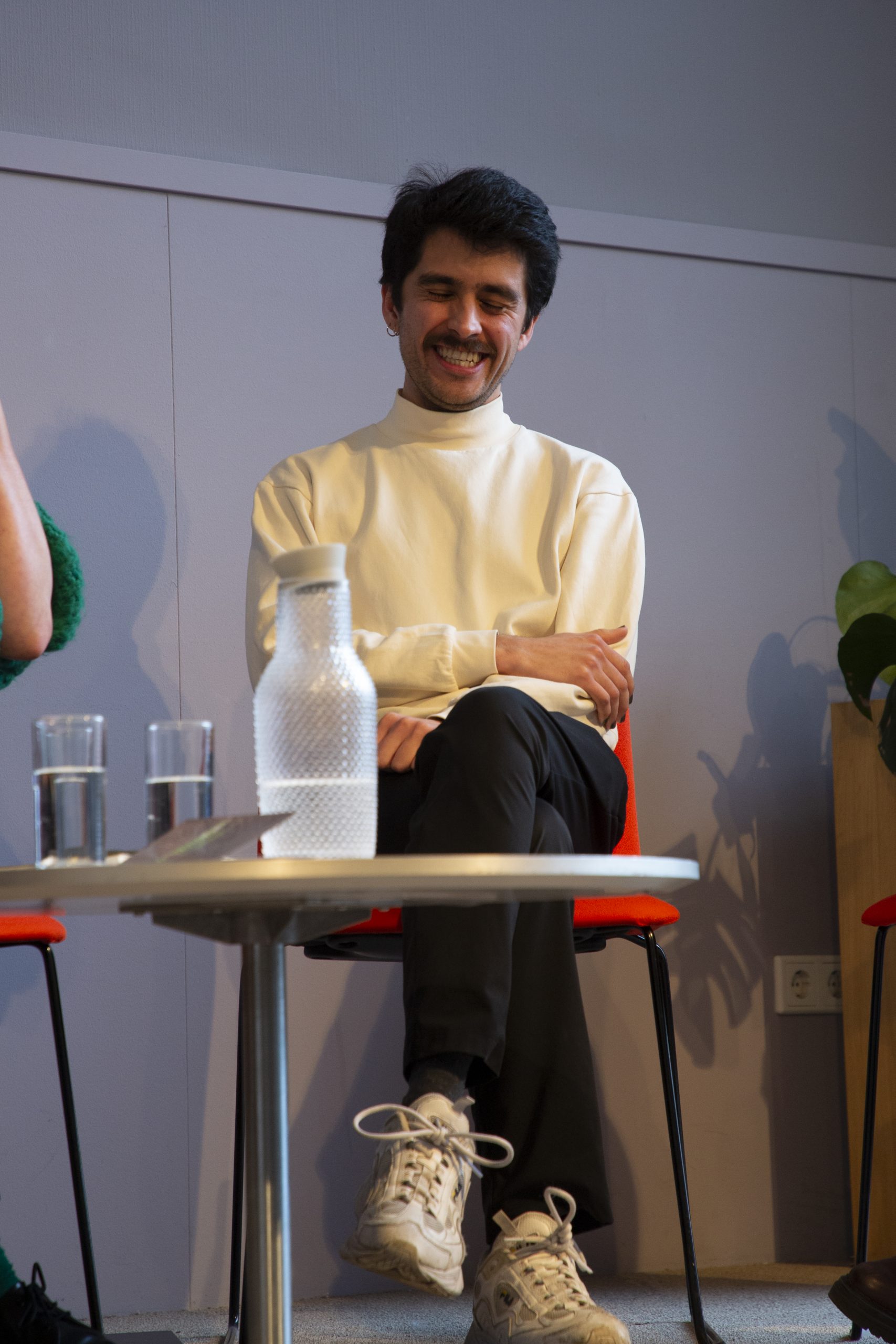
Jordi Viader Guerrero
Dunja asks for a reflection on the tension between the visual field on TikTok and invisible, what structures our experience on the platform. The visual field is the main arena of possibility, TikTok is a visual platform or medium. She asks “What is the relationship between visual medium and user tactics?”
Agnieszka says that the visual language of trends like #nichetok, #corecore and #philosophytok makes invisible TikTok visible. There is a visual busyness. She says that “users reflect more consciously on the more embodied, practice and experience of scrolling, consuming and interacting.” There is even more to be said about the comment section, it provides the potential for some sort of exchange which is often meaningless and surface level but maybe not. It is a “new sort of structure for interaction that is more referential to other platforms and other ways of engaging” there may even be ways to get off the platform together somehow and revisit it later.
Tina remarks that TikToks don’t actually make boredom visible at all, they instead show users what to do when bored. This is the paradox of digital formats. It is rendering boredom invisible, hiding it all together.
Dunja then asks “what is the relationship between what the platform requires users to visualise and how users are using these visual affordances on the platform to ponder on all of these invisible structures that flow through the platform?”
Jordi responds with questions of his own: “How do we act tactically with the visual?” He is more interested in all of the practices around the visual, both production and consumption. “What are we doing with these practices, how can we make these practices tactical or political rather than something of the world? Is art production a way of political engagement in the world or is it something outside the world?” It is more about the practices around it, changing how we see it. Reconceptualizing the practices.
And with that the floor opens to audience questions. The first audience member states that corecore has gone alt-right, as part of the manosphere it is where men scream their anguish. This is not just due to the algorithm, he wonders is this the new 4chan? Similar ephemeriality and dadaist form that becomes the alt-right medium. Agnieszka says that it is interesting to consider corecore as something that is already gone. She still has a sense of hopefulness within her that we haven’t lost it completely to the far right. Perhaps it is something that is mutating and transforming/overlaping into this niche side of titkok that has a hope angle, like #philosophytok or #hopetok, which have little no association with conservation politics. She leaves the possibility open, saying, “let’s see.”
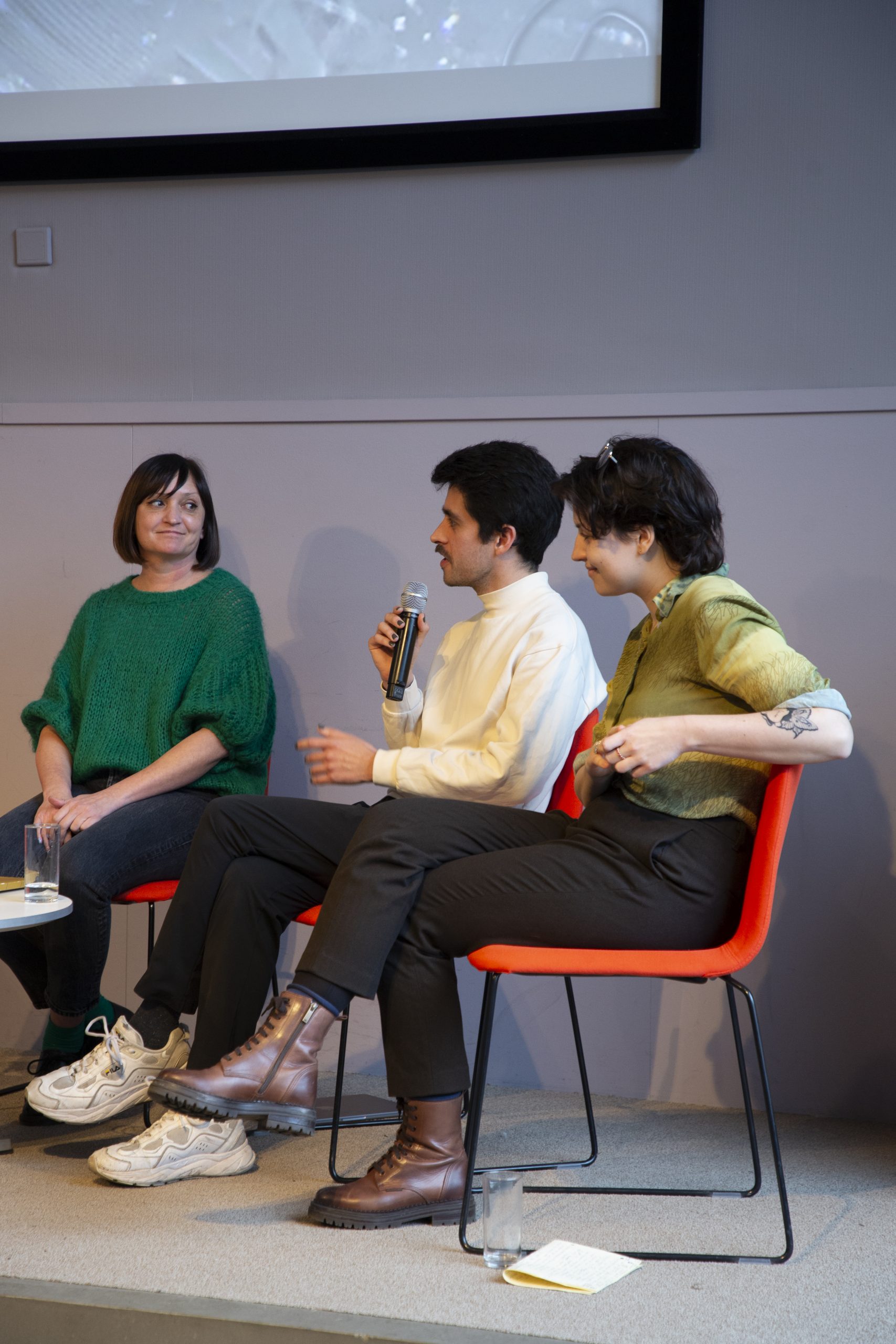
Tina Kendall, Jordi Viader Guerrero and Agnieszka Wodzińska
Geert Lovink is the next audience member to contribute. He sees infinite scroll as “a regressive phenomenon, an end of the social of social media, end of community.” He says it is a subliminal activity, pleasure of braindead activity. It has gone full circle, only one step away from full automation and is another form of zapping of the television channels. “The early internet was presented as a critique of this passivitiy, you can participate, create, take over the media. Do you think scrolling has this almost automated nature?”
Jordi responds that “scrolling in and of itself will not get us anywhere.” Scrolling can be described as a regressive gesture, a machinization of our movements and therefore dangerous politically. The novelty of it comes precisely out of when you do something different. “All of our actions are mediated by technical systems, there is no difference between scrolling and joining a political party” like all the actions we do collectively in the world together. We must convert it into something that is more than machinic and make other actions around it. Not letting the scrolling define itself for us. There is a revolutionary potential of collage, while the collage had been co-opted by corporations for advertisements, scrolling can be considered like passive surfing channel consumption. The key is to use the gestures and affordances differently.
Geert adds that there is a subconscious production of power. Jordi agrees that the embedded automatism is very difficult to fight against, and jokingly says we should make our own psyops. Dunja responds that reconceptualization of scrolling is not subliminal, it is very conscious.
Finally, Tina concludes the panel by adding that people are incredibly conscious of their digital consumption, especially during the pandemic. Symbolically the infinite scroll was very comforting in the context of the pandemic. It was almost a meditative act, there is value in thinking about those sorts of gestures as providing comfort as well as acknowledging how it can be deeply problematic.


